On the beautiful islands of the Seychelles in the Indian Ocean grows a legendary palm called Lodoicea maldivica, also known as the double coconut or coco-de-mer. This palm produces the largest and heaviest seeds in the world, weighing up to an impressive 25kg and measuring up to half a meter long. These seeds, with their suggestive shape, attract scientists, tourists, and even poachers. The double coconut is of high interest due to its aesthetic wonder and the legends surrounding its supposed medicinal properties. However, due to overharvesting, there are now only around 8,000 mature Lodoicea palms left in the wild, making them an endangered species listed on the IUCN Red List.
Key Takeaways:
- The Lodoicea maldivica palm produces the world’s largest and heaviest fruit seeds.
- The seeds can weigh up to 25kg and measure up to half a meter long.
- The double coconut is endangered due to overharvesting, with only around 8,000 mature palms remaining in the wild.
- Scientists, tourists, and poachers are attracted to the aesthetic wonder and legends surrounding the double coconut.
- Conservation efforts are crucial to protect this unique species and preserve biodiversity.
The Evolution of the Double Coconut
Researchers at the Royal Botanic Gardens, Kew have been studying Lodoicea maldivica to understand the evolutionary factors behind the development of its large seeds. They have discovered that several conditions needed to be met in a specific order for the double coconut to evolve. Firstly, the plants had to have a large size with few-branched inflorescences to accommodate large seeds. Secondly, they needed to exist in shady habitats or have large seed-dispersing animals that could transport the seeds to suitable locations. Lastly, there had to be a lack of dispersal agent, which led to the production of fewer, but larger, seeds to minimize plant competition.
The relatives of the double coconut only met the first two conditions, suggesting that the absence of large seed-dispersing animals in the Seychelles allowed the gigantic seeds of Lodoicea to evolve. It remains unknown if Lodoicea will continue to evolve and produce even bigger seeds in the future.
As shown in the table below, the evolution of large seeds in Lodoicea can be attributed to the specific conditions and factors described above:
| Evolutionary Factors | Role in Seed Evolution |
|---|---|
| Large size with few-branched inflorescences | Accommodate large seeds |
| Existence in shady habitats or presence of large seed-dispersing animals | Transport seeds to suitable locations |
| Lack of dispersal agent | Production of fewer, but larger, seeds to minimize plant competition |
Studying the evolution of Lodoicea and its large seeds provides valuable insights into the complexity and adaptability of plant life. By understanding the conditions necessary for the existence of the double coconut, scientists can better comprehend the factors that contribute to plant evolution and the potential threats they face, such as extinction.
Protecting the Double Coconut
To prevent the double coconut from going extinct, conservation efforts have been put in place. The seeds in the wild and in botanical gardens worldwide that have managed to grow Lodoicea palms are carefully guarded and sometimes placed in cages to protect them from poachers.
There are currently only around 8,000 wild mature Lodoicea palms on the islands of Praslin and Curieuse in the Seychelles, so preserving these seeds is crucial for the species’ survival. Additionally, studying Lodoicea and its relatives can provide valuable insights into the evolutionary forces that drive plants to produce large seeds.
Conservation efforts play a vital role in safeguarding endangered species and protecting biodiversity. By raising awareness and implementing measures such as habitat preservation, protection against poaching, and seed preservation, we can ensure the survival of remarkable species like the double coconut.
The Fascinating History of the Coco de Mer Seed
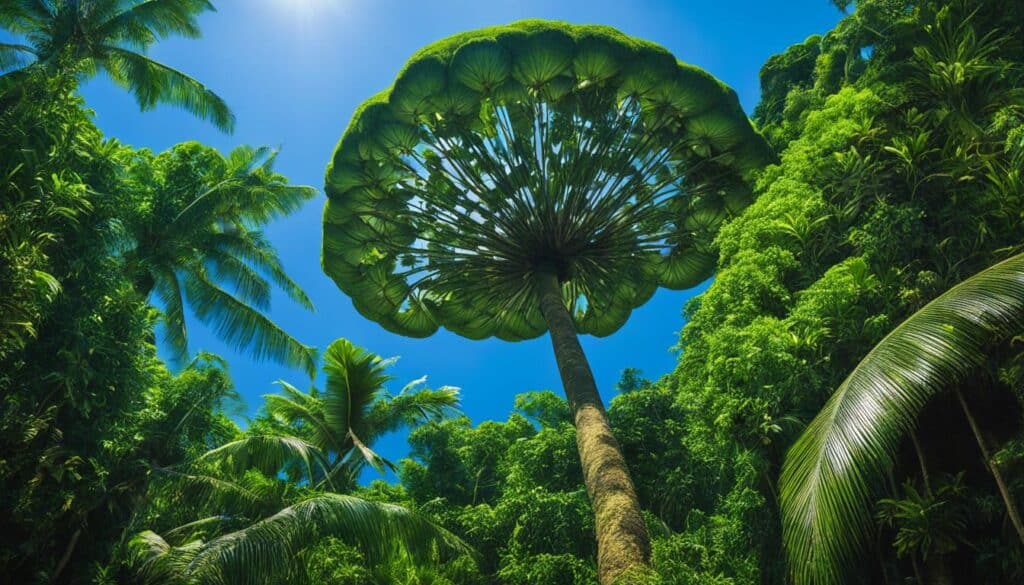
The coco de mer seed, also known as the double coconut, has a captivating history that dates back to the islands of Praslin and Curieuse in the Seychelles. These seeds are known for their incredible size and unique shape, making them a subject of fascination and wonder.
Measuring up to 12 inches in length, nearly 3 feet in circumference, and weighing over 40 pounds, the coco de mer seed is truly awe-inspiring. But it’s not just the size that sets it apart. The shape of the seed is quite remarkable, resembling a pair of female buttocks.
“The coco de mer seed has a rich tapestry of legends and folklore surrounding it. Some tales suggest that the male and female trees of the coco de mer come together for nights of passion, while others relate it to the forbidden fruit from the Garden of Eden.”
The intriguing legends and folklore associated with the coco de mer seed add to its mystique. People have marveled at its shape and crafted stories around its origins and significance. From tales of love and passion to the symbolism of the forbidden fruit, the coco de mer seed has captured the human imagination for centuries.
The rarity of the coco de mer seed has also made it highly prized. Throughout history, princes and emperors have paid exorbitant prices to own these remarkable seeds, cherishing them as symbols of wealth and beauty.
The Legends and Folklore of the Coco de Mer Seed
| Legends and Folklore | Meaning |
|---|---|
| The Love-Making of the Trees | Suggests the intimate connection between the male and female coco de mer trees. |
| Forbidden Fruit from the Garden of Eden | Alludes to the temptation and allure associated with the coco de mer seed. |
| Symbol of Fertility and Beauty | Highlights the seed’s unique shape and natural wonder. |
The legends and folklore surrounding the coco de mer seed showcase the cultural significance it holds in different societies. Its shape and size continue to captivate and inspire, ensuring that the coco de mer remains an enchanting part of our natural world.
The Coco de Mer Tree and its Environment
The coco de mer tree is an enormous palm that can grow up to 34 meters tall. It has fan-shaped leaves that are 7 to 10 meters long and 4.5 meters wide. The tree is dioecious, meaning it requires separate male and female plants for reproduction.
It is found on the islands of Praslin and Curieuse in the Seychelles, growing on nutrient-starved, rocky soil. These palms have adapted to the scarcity of nutrients by being frugal in their resource usage. They can sprout fronds using only about one-third of the nutrients needed by other neighboring trees and shrubs. Additionally, coco-de-mer palms can reuse 90% of the phosphorus contained in the fronds they are about to shed.
The Growth and Germination of Coco de Mer Seeds
The growth and germination process of coco de mer seeds is a fascinating journey that spans several years. Due to the nutrient-poor soil in which they grow, these seeds have a long maturation period and a carefully timed reproduction timeline.
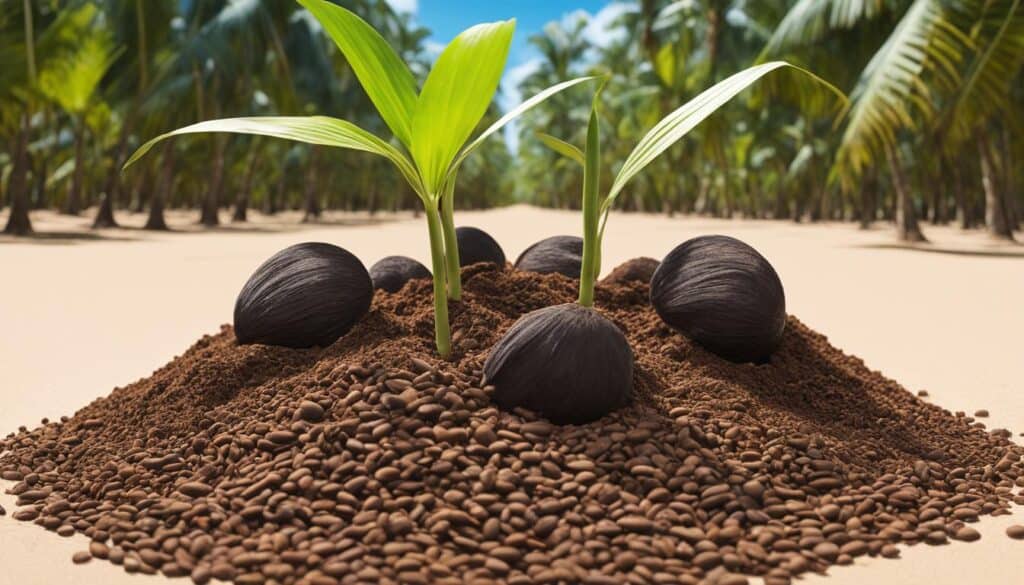
Seed growth and maturation: It takes approximately six to seven years for a single coco de mer seed to reach maturity. During this time, the seed undergoes significant development, gaining the nutrients and resources necessary for its next phase of life.
Germination: Once a coco de mer seed has reached maturity, it enters the germination stage. This can take an additional two years for the seed to sprout and begin its journey as a new plant.
However, germination won’t occur until the palm has reached reproductive maturity, which can take around 80 to 100 years. This long maturation period ensures that the palm is fully prepared to reproduce and propagate its species.
Reproduction Timeline
The reproductive timeline of the coco de mer palm is slow and deliberate. It takes decades for a single palm to reach reproductive maturity and begin producing seeds. During its lifespan of several hundred years, a female coco de mer palm may only produce about 100 seeds.
This reproductive strategy is an adaptation to the challenging environment in which the coco de mer grows. The nutrient-poor soil requires the palm to invest significant time and resources into maturation and reproduction, ensuring the survival of its offspring in a harsh ecosystem.
| Stage | Duration |
|---|---|
| Seed growth and maturation | 6-7 years |
| Germination | 2 years |
| Reproductive maturity | 80-100 years |
| Seed production | Throughout lifespan, approx. 100 seeds |
This extended growth and maturation process, combined with the slow reproductive timeline, highlights the delicate balance between the coco de mer palm and its environment. It is a testament to the resilience and adaptive strategies of nature’s remarkable creations.
The Influence of the Coco de Mer Seed’s Shape
The coco de mer seed’s unique shape has captivated people around the world, sparking legends and beliefs associated with its appearance. Resembling a pair of female buttocks, this distinctive shape has given the seed a special status and made it the subject of fascination and desire throughout history.
According to some stories, witnessing the love-making of the male and female trees of the coco de mer can lead to blindness or even death. This belief further adds to the allure and mystique surrounding the seed. Others, like the British Army officer Major General Charles George Gordon, have drawn parallels between the coco de mer seed and the forbidden fruit in the Garden of Eden, symbolizing temptation and forbidden desires.
“It is not too much to exaggerate, the coco de mer is the cursed fruit of the Garden of Eden. I never thought that Adam and Eve were real personages until I came across the coco de mer. To be particular it is the fruit of the female tree which is a more precise counterpart of the apple.” – Major General Charles George Gordon
The historical significance of the coco de mer seed extends beyond legends and beliefs. Its unique shape and rarity have made it highly prized throughout history. Princes and emperors have paid exorbitant amounts to own these seeds, symbolizing wealth, luxury, and exclusivity.
| Legends and Beliefs | Historical Significance |
|---|---|
| Associated with blindness or death when witnessed | Prized by princes and emperors |
| Linked to forbidden fruit in the Garden of Eden | Symbol of wealth, luxury, and exclusivity |
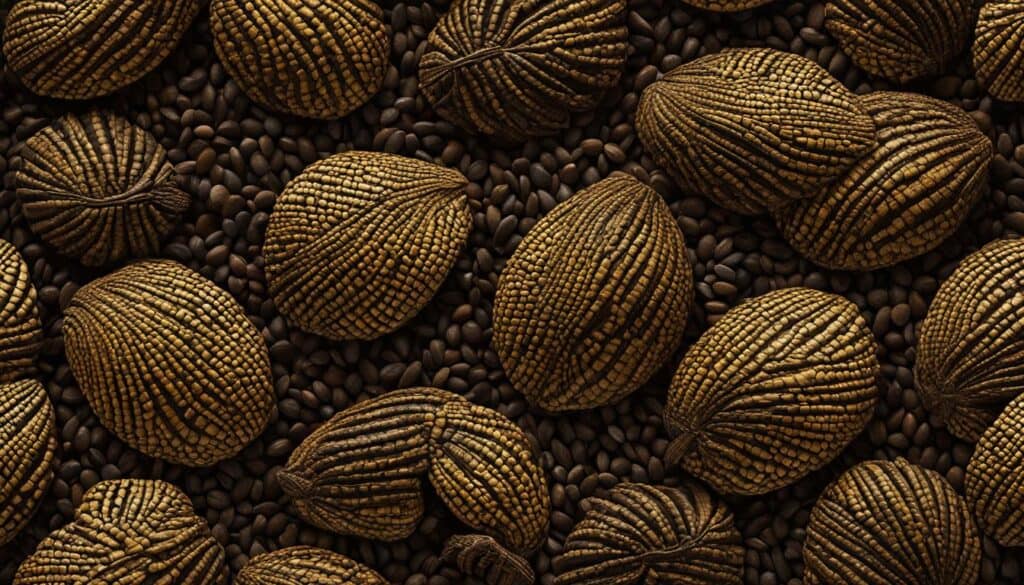
The intriguing shape of the coco de mer seed continues to capture the imagination and fuels our fascination with this natural wonder.
The Wealth of Rare Floating Seeds
The coco de mer fruits, which contain the seeds, are very heavy, sinking to the bottom of the sea when they fall into the water. Over time, the husk of the fruit decays and gases form, causing the seed to rise to the surface.
Sailors have discovered these rare floating seeds and believed them to be “sea coconuts,” leading to the name coco de mer, which means “coconut of the sea.” The rarity and uniqueness of these seeds made them highly sought after, with princes and emperors paying high prices to own them.
The historical significance and value of the floating coco de mer seeds add to their allure.
| Seed Attributes | Rarity | Historical Significance |
|---|---|---|
| Size and Weight | Enormous | Sought after by princes and emperors |
| Appearance | Distinctive and unique | Captivating legends and folklore |
| Preservation | Challenging due to scarcity | Symbol of rarity and value |
Other Remarkable Large Seeds
The coco de mer is not the only plant that produces large seeds. There are other notable examples from various plant families. Let’s explore some remarkable seeds found in the natural world:
The Coconut Palm
The coconut, known for its delicious fruit, also produces sizable seeds. One notable variety is the Andaman Giant Coconut, which can weigh up to 8 pounds. These large seeds contribute to the coconut palm’s ability to disperse and propagate across different regions.
Mora
The Mora tree, found in tropical rainforests, produces large, oblong seeds that can reach sizes of up to 10 centimeters in length. These seeds are essential for the growth and survival of the Mora tree, as they harbor nutrients and provide energy for germination.
Borassus Sundaicus
The Borassus Sundaicus, a species of palm tree commonly found in Southeast Asia, bears enormous seeds. These seeds can weigh up to 18 pounds and are known for their impressive size and nutritive value. They are a significant food source for wildlife in the region.
Pelliciera Rhizophorae
The Pelliciera Rhizophorae, also known as the “mangrove apple” or “bay cedar,” produces large, round seeds. These seeds have a distinctive appearance with a bumpy surface and can grow up to 4 centimeters in diameter. They serve as vital resources for the regeneration of mangrove ecosystems.
These are just a few examples of the diverse range of plant families that produce remarkably large seeds. These seeds play critical roles in plant reproduction, dispersal, and survival. The variations in seed size across different species showcase the fascinating adaptations and strategies employed by plants to ensure their successful propagation.
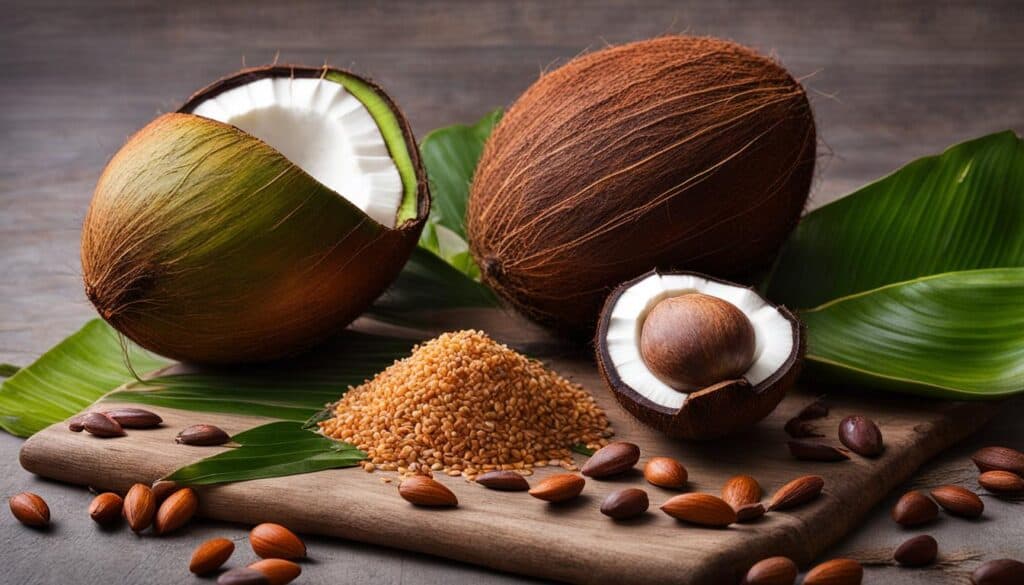
The Importance of Conservation
The coco de mer serves as a powerful reminder of the critical importance of conservation and the preservation of plant species. Many plants, including the coco de mer, face the imminent threat of extinction. These plants have evolved over millennia, adapting to their environments and playing unique roles in the delicate balance of ecosystems. Once these species go extinct, it becomes exceedingly difficult, if not impossible, to restore them.
Preserving plant species is crucial because they provide essential ecosystem services and contribute to biodiversity. Plants play a significant role in maintaining the health and stability of ecosystems by producing oxygen, filtering air and water, supporting pollinators and wildlife, and controlling soil erosion. By protecting and conserving plant species, we safeguard the intricate web of life on our planet.
Biodiversity, the variety of life forms on Earth, is essential for the resilience and sustainability of ecosystems. Each species, including plants, plays a unique role in the intricate web of interactions and dependencies that make up an ecosystem. Losing a single species can have cascading effects, disrupting the balance and functioning of the entire ecosystem. Preserving plant species is crucial for protecting the overall biodiversity of our planet.
“In the end, we will conserve only what we love, we will love only what we understand, and we will understand only what we are taught.”
— Baba Dioum
Conservation efforts are essential to protect our natural heritage and ensure the survival of endangered plant species like the coco de mer. Through initiatives such as habitat preservation, restoration projects, and seed banks, we can actively contribute to the preservation of these remarkable plants for future generations.
The Fragility of Ecosystems
Ecosystems are intricate, interconnected webs of life, and every component plays a vital role. The loss of even a single plant species can disrupt the delicate balance and functioning of an ecosystem. The fragility of ecosystems highlights the urgency and importance of conservation efforts. By protecting plant species like the coco de mer, we safeguard not only their beauty and wonder but also the health and sustainability of entire ecosystems.
Preserving Plant Species: A Call to Action
The preservation of plant species is not only necessary for the survival of individual plants but also for the well-being of our planet and future generations. It is a shared responsibility that requires collective action and support. Whether through supporting conservation organizations, advocating for stronger environmental policies, or making sustainable choices in our daily lives, we can all contribute to the preservation of plant species and the protection of biodiversity.
| Preserving Plant Species | Protecting Biodiversity | The Fragility of Ecosystems |
|---|---|---|
| – Conservation efforts | – Essential for ecosystem resilience | – Interconnected web of life |
| – Habitat preservation | – Each species has a unique role | – Loss of a single species can disrupt |
| – Restoration projects | – Contribute to overall biodiversity | – Fragility highlights the importance |
| – Seed banks | – Protection of ecosystem services |
Preserving plant species and protecting biodiversity are not only about safeguarding nature but also about ensuring our own well-being. It is through these species and ecosystems that we find clean air, clean water, food, medicine, and countless other resources that sustain us. By recognizing the value of these natural marvels and taking action to protect them, we can create a more sustainable and harmonious future for all.
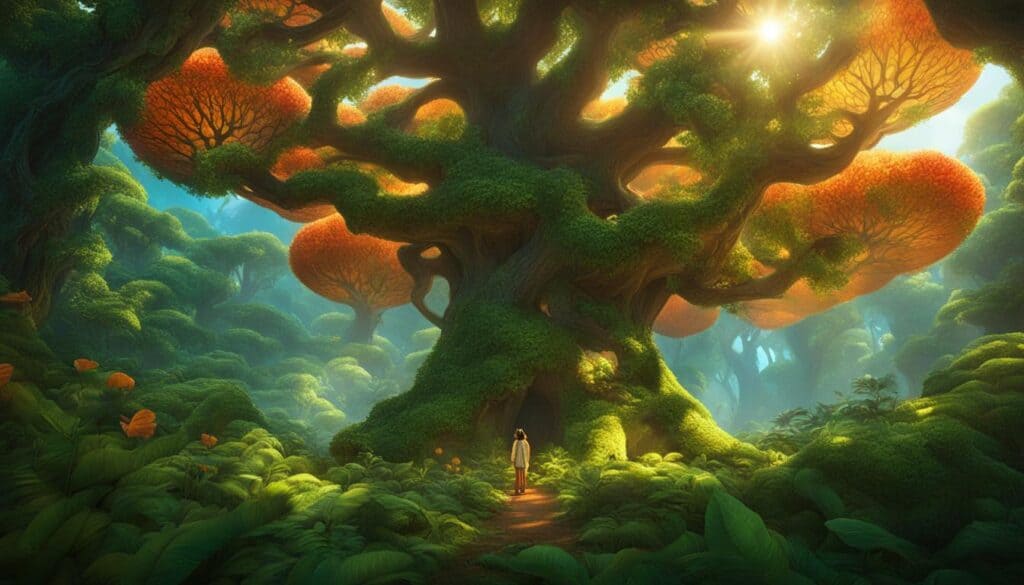
Conclusion
The double coconut, also known as the coco-de-mer, is a truly extraordinary natural marvel. With its record-breaking seed size and unique shape, it captivates scientists and tourists alike. However, this magnificent species is now at the brink of extinction due to overharvesting and habitat loss.
Studying the evolution of Lodoicea maldivica and its giant seeds provides valuable insights into the forces that shape plant life. The double coconut’s existence is a testament to the complex interplay of ecological factors that have allowed it to develop its enormous seeds.
Conservation efforts are of utmost importance to protect the double coconut and preserve the biodiversity it supports. By conserving plant species and safeguarding our natural ecosystems, we can ensure the sustainability of our environment and the well-being of future generations. It is our responsibility to cherish and protect these remarkable wonders of nature.
FAQ
What is the biggest fruit seed in the world?
The biggest fruit seed in the world is the seed of the double coconut or coco-de-mer palm tree, scientifically known as Lodoicea maldivica.
How large and heavy can the seeds of the double coconut grow?
The seeds of the double coconut can weigh up to an impressive 25kg and measure up to half a meter long.
Why is the double coconut palm endangered?
The double coconut palm is endangered due to overharvesting and habitat loss, with only around 8,000 mature palms remaining in the wild.
What conditions were necessary for the double coconut to evolve?
Several conditions needed to be met for the double coconut to evolve, including large plant size, limited competition, large seed-dispersing animals, and a lack of dispersal agents.
What conservation efforts are in place to protect the double coconut?
Conservation efforts include guarding the seeds in the wild and botanical gardens and implementing measures to prevent poaching, such as placing seeds in protective cages.
What legends and folklore are associated with the coco de mer seed?
There are various legends and folklore surrounding the coco de mer seed, including stories of the male and female trees coming together for nights of passion and associations with the forbidden fruit from the Garden of Eden.
What other remarkable plants produce large seeds?
Other plants that produce large seeds include the coconut palm, Mora, Borassus sundaicus, Pelliciera rhizophorae, and many more.
Why is conservation important for plant species like the double coconut?
Conservation is crucial for preserving plant species and protecting biodiversity, ensuring the sustainability of ecosystems, and maintaining the wonders of nature for future generations.





Leave a Reply